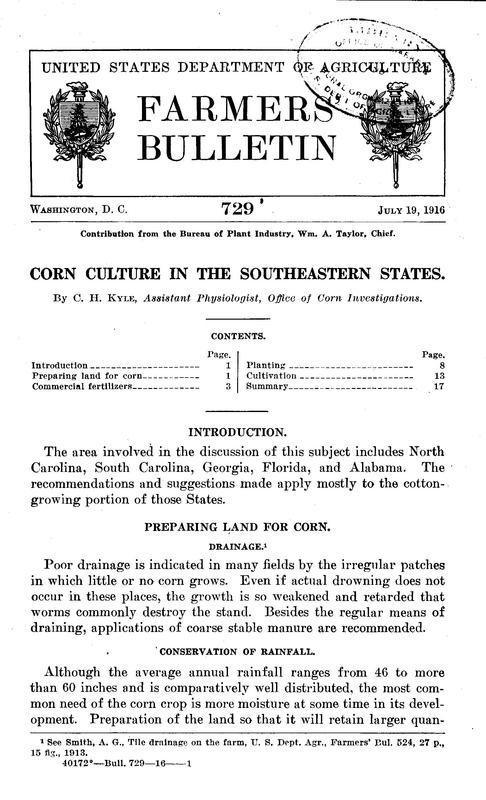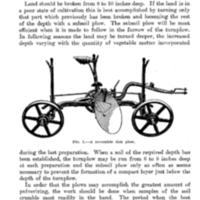Corn Culture in the Southeastern States
Creator
Date
1916
Subject
Excerpt
The recommendations and suggestions made in this bulletin apply firstly to the cotton-growing sections of North Carolina, South Carolina, Georgia, Florida, and Alabama.
Drainage and coarse stable manure should be used to prevent the irregular patches in the field in which little or no corn grows.
More of the rainfall is retained when the land is broken from 8 to 10 inches deep and vegetable matter is supplied.
Humus economizes the labor of tilling the land and prolongs the good effects of cultivation.
Crops like cowpeas, velvet beans, vetch, the clovers, and beggar- weed may be made to supply both humus and nitrogen.
Commercial fertilizers should be used to supply such elements of plant food as can not be supplied by the soil and by cropping systems in sufficient quantity for the greatest profit.
The fertilizer formulas published by the North Carolina and South Carolina agricultural experiment stations are recommended.
Budworms may make it necessary to plant after the first of May, but drainage and coarse stable manure may relieve this condition.
Drainage and coarse stable manure should be used to prevent the irregular patches in the field in which little or no corn grows.
More of the rainfall is retained when the land is broken from 8 to 10 inches deep and vegetable matter is supplied.
Humus economizes the labor of tilling the land and prolongs the good effects of cultivation.
Crops like cowpeas, velvet beans, vetch, the clovers, and beggar- weed may be made to supply both humus and nitrogen.
Commercial fertilizers should be used to supply such elements of plant food as can not be supplied by the soil and by cropping systems in sufficient quantity for the greatest profit.
The fertilizer formulas published by the North Carolina and South Carolina agricultural experiment stations are recommended.
Budworms may make it necessary to plant after the first of May, but drainage and coarse stable manure may relieve this condition.
Title
Corn Culture in the Southeastern States
File(s)
Corn Culture in the Southeastern States 1.jpg
(image/jpeg)
Corn Culture in the Southeastern States 2.jpg
(image/jpeg)
Corn Culture in the Southeastern States 3.jpg
(image/jpeg)
 An official website of the United States government.
An official website of the United States government.




